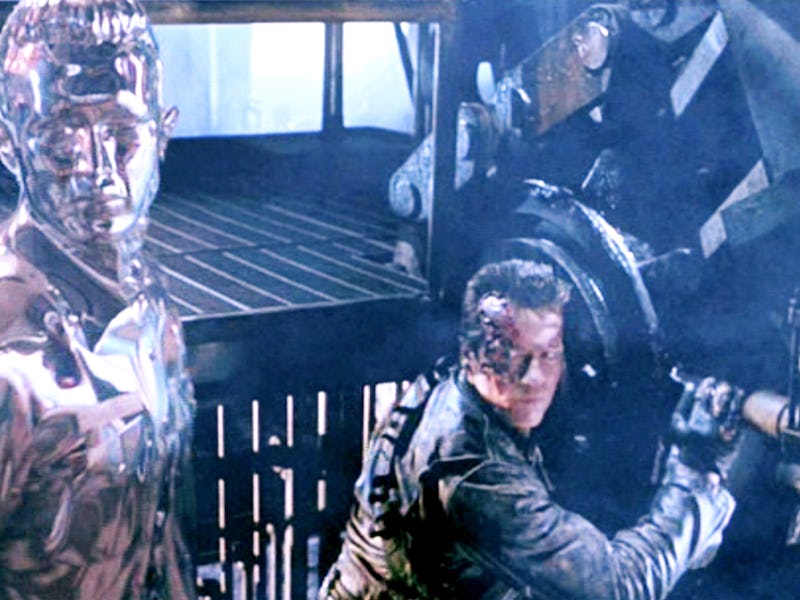Scientists Discover How to Build a Terminator-style Self-Healing Metal
Don't worry about killer robots — the bigger application is in space construction.

The Terminator series is any metallurgist’s dream. Across all six films, including two good ones, futuristic human-killing robots showcase all the sci-fi possibilities of metal — both resistant against an endless barrage of bullets and capable of taking any conceivable shape (just to name a few). But one of the most incredible far-future innovations is a Terminator’s self-healing metal body, sealing up catastrophic fractures in a blink of an eye.
Back in 21st century pre-Judgment Day Earth, scientists understand that metals can’t just self-heal like other materials, such as advanced polymers or Roman concrete — or at least, they used to believe that. In a new article published today in the journal Nature, scientists from Sandia National Laboratory and Texas A&M University witnessed for the first time the microscopic self-healing capabilities in pure platinum and copper by a process known as cold welding, a technique where two metals fuse without the need of heat or electric current.
“This is happening natively in ordinary metals,” Sandia staff scientist and co-author Brad Boyce tells Inverse. “This may already be happening to some extent [in steel today], but we don’t know for sure. What we’ve been able to observe is at the nanoscale in a specialized laboratory condition where we can see through the metal with 40 nanometers of thickness.”
Metal, heal thyself
The idea of self-healing ordinary metals isn’t new. Back in 2013, Texas A&M materials science professor Michael Demkowicz (then an associate professor at MIT) used computer modeling to uncover that metals could theoretically heal themselves. Fast forward 10 years later, and Boyce’s team — along with Demkowicz help — finally found real world evidence.
Boyce says this breakthrough was made largely possible due to advancements in the fidelity of specialized transmission electron microscopes. These microscopes allowed Boyce and his team to conduct metal fatigue experiments using extremely fine levels of force applied to nanometer-sized metal films.
“These films that we’re looking through are vanishingly thin — they’re a handful of atoms, so the forces you need to apply to such a thin film before it rips apart are hard to relate to,” Boyce says. “Think of one mosquito’s leg — that’s the type of force we’re applying.”
During the experiment, Boyce applied this bug-sized force 200 times per second to a thin metal film to simulate fatigue. After about 40 minutes into the experiment, the metal’s damage reversed course. On one end, the crack appeared to retrace its steps and seal up its former injury without a trace, according to Sandia’s press release.
The metal’s self-healing occurs in local areas of compressive stress where two edges of a crack are pressed together. This also includes (but isn’t necessarily limited to) grain boundary migrations — or defects in the crystalline structure of metals that move around during fatigue loading. As a defect moves, these migrations induce a compressive stress that in turn activates a metal’s cold-welding capabilities.
And although Boyce knew about Demkowicz work in this area, seeing the visual evidence of this self-healing ability took him by surprise.
“A postdoc (co-author Khalid Hattar) came in one day and was showing this video, saying ‘well, I thought this was pretty interesting.’ My jaw hit the ground, and I said ‘if what you’re showing me is real, that’s not just interesting — that’s a paradigm shift.’” Boyce says, “Our original intent was just to watch grain boundaries move around during fatigue loading…we didn’t expect the crack to heal itself as a result.”
Finding the Terminator Sasquatch
After his team sifted through hours of video and finding what he compares to “sighting Sasquatch,” Boyce reached out to Demkowicz who then performed the experiment on his computer models. He successfully confirmed Boyce’s results and also computationally replicated this self-healing ability in other metals beyond just copper and platinum.
Because of the incredibly small and precise nature of the experiment, it was necessary to isolate the metal film in a vacuum so no atmospheric atoms were interfering with the results. It’s unclear whether atmospheric particles, particularly oxygen, could inhibit cold welding as the process requires a pristine surface (which a vacuum certainly provides). But even if this self-healing capability occurs only in a vacuumous state, that’s still very important for building spacecraft and also understanding subsurface fatigue, which occurs in such environments.
“That’s really going to be a big question for future studies,” Boyce says. “We’re thinking of some clever future experiments that’ll allow us to leak in different atmospheres and see how they slow, change, or alter this process.”
I said ‘if what you’re showing me is real, that’s not just interesting — that’s a paradigm shift.’
Fatigue failure, along with corrosion, are the vast majority of reasons why infrastructure, whether bridges, plane turbines, or any other metal structure, frequently need replacing. Understanding this new self-healing ability could help engineers better understand how metals will hold up to stresses while potentially designing materials that take advantage of grain boundary migration and local compressive stress to induce this self-healing. It’s even possible that metal strengthening techniques (such as shot peening) that intentionally create compressive stresses on a metal’s surface are already taking advantage of metal’s nanoscale self-healing without even knowing it.
For now, it’s unknown how this self-healing ability plays out across different metals or how important this mechanism is in conjunction with the decades worth of papers, equations, and methods determining how long a metal component can survive — but its discovery could lead materials science in a whole new direction.
“This is a new mechanism added into a litany of mechanisms that were already believed to be known,” Boyce says. “Does this one just pile on top of everything else that’s happening…or is this more dominant than we ever really imagined?”
It’s no self-healing robot, but it’s a start.
This article was originally published on